Das Kupferstichspiel des I.M.F. von 1617
Playing cards had been made as precious objects for wealthy clients since the late 14th century. They were made to look at, admire and to keep in curiosity cabinets, or perhaps to entertain ladies or educate children rather than to play with.
Engraved Playing Cards, Germany, 1617
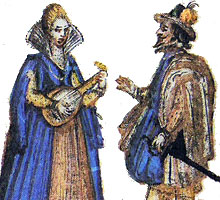
by an anonymous artist with the initials I.M.F.
Playing cards had been made as precious objects for wealthy clients since the late 14th century. They were made to look at, admire and to keep in curiosity cabinets, or perhaps to entertain ladies or educate children rather than to play with. These packs often depicted the upper ranks of social hierarchies, as well as trades and vocations, not without parody or satire. Sometimes these miniature art pieces inspired cruder, simpler versions made for play, printed from woodblocks by a commercial artist or woodcutter. Thus their existence had some influence on the everyday, more affordable playing cards which were also being produced.

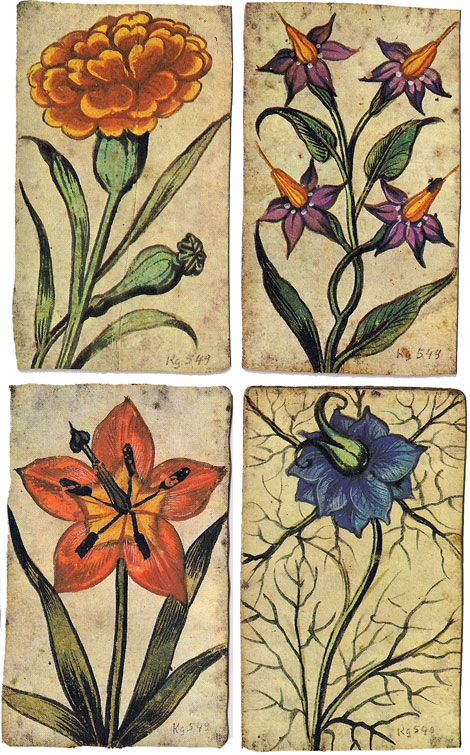
Above: images from the 1979 Edition Leipzig facsimile that was limited to 999 numbered copies. The facsimile was issued with a 55 page booklet written in German and English. As the booklet points out, this deck, of which there is only one original in existence, was made in the first instance to be a collectable keepsake. This is known from the fact that each card has a different floral back design rendering actual play useless because the value of each card would soon be learned from the particular floral back. There is no attribution to any artist although the engraver, I.M.F is identified on the Nine of Hearts and the name of the publisher, Heinrich Muller, appears on the Four of Hearts. Thanks is given in the booklet to the Staatliche Museen Heidecksburg, Rudolstadt for permission to reproduce in facsimile the original cards in their possession.
Expensive playing cards, gold edged and printed from copper plates, were available for those who could afford them. The demand for these copper-plate engraved cards must have been great because a fair number of examples have survived from the fifteenth and sixteenth centuries, usually preserved in curiosity cabinets. Although they were rather exclusive items, often they highlight artistic trends, styles and influences from other places, and were also inspiration to commercial workshops where cheaper cards were being produced. Thus it could be argued that the elite were able to influence the lower classes through their expensive playing cards! However, the argument can also be turned the other way, since some examples of fifteenth century woodcut cards can be seen to have influenced copper-plate engraved cards.
In the example we have here, the four Kings are mounted on thrones whilst the Upper and Lower Valets are standing, their suit signs being respectively high or low. The numeral cards have the suit signs at the top, embellished with ornamental scrolls, and small illustrations or vignettes at the bottom. These are all of interest on account of their artistic freedom and were, of course, the standard format for German-suited cards in those days.
However, perhaps the most striking aspect are the watercolour floral paintings on the reverse, which are botanically accurate representations and thus of educational value. It is not known whether they are by the same artist who painted the cards; possibly by someone who practised miniature painting.
• See the box►
REFERENCES
Fournier Museum, Playing Cards, Germanic countries no. 14
Hoffmann, Detlef: The Playing Card, an illustrated history, Edition Leipzig, 1973
Images of the facsimile edition from the collection of Rod Starling, author of "The Art and Pleasures of Playing Cards".
By Rod Starling (1936-2023)
United States • Member since January 09, 2013
Rod Starling was one of the founding members of the 52 Plus Joker card collectors club. He authored many articles for the club's quarterly newsletter, Clear the Decks. His collection encompasses both foreign and American decks. Rod also authored a book titled The Art and Pleasures of Playing Cards.

Leave a Reply
Your Name
Just nowRelated Articles

Early German playing cards
Some early examples of popular German playing cards from the XV and XVI centuries.

History of Playing Cards explained in 5 Minutes
Video by Art of Impossible. In this video you will get a short overview of the most important histor...
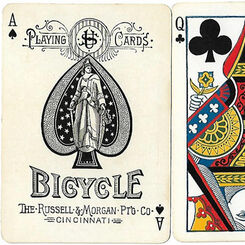
Bicycle Playing Cards, 1st edition
1st edition of famous Bicycle Playing Cards printed by Russell & Morgan Printing Co., Cincinnati, 18...
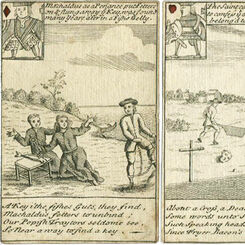
Illustrated Playing Cards, c.1740
Illustrated playing cards featuring comical engravings and rhymes about saints, c.1740.
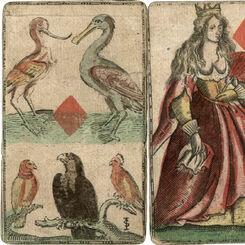
XVII Century Engraved Animal Cards
Anonymous French-suited German engraved cards c1610 to 1650.

Delightful Cards, c.1723
Delightful Cards, containing variety of entertainment for young Ladies and Gentlemen c.1723.

Master of the Playing Cards
Animal suited playing cards engraved by the Master of the Playing Cards, Germany, c.1455
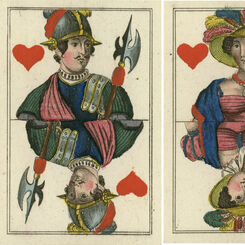
Unknown Maker
Early German deck by unknown maker, c.1825
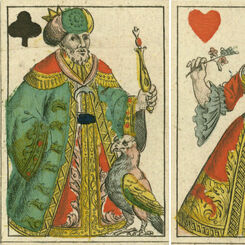
Joseph Losch
French-suited pack with full-length courts by Joseph Losch, c.1800.
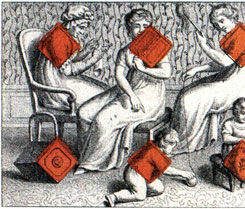
Cotta Transformation playing cards
In 1804, J.G. Cotta, a publisher and bookseller in Tübingen, Germany, produced the first set of tran...
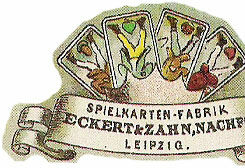
Deutsches Schützenfest 1884
This deck was apparently made to commemorate a Shooting Festival held in Leipzig in 1884
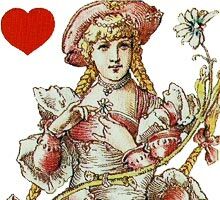
Luxus Skatkarten
The cards are from a facsimile edition published by F. X. Schmid, Munich, in 1981. The artist is unk...
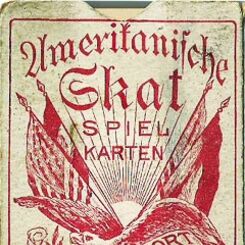
American Skat
These decks were produced in various grades for the German immigrant population and feature the Germ...
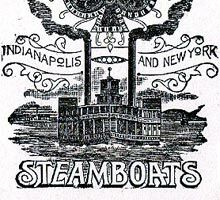
The Steamboat Brand
The theme of steamboats navigating up and down the Mississippi also extended to the cotton plantatio...

Triplicate No.18
Dougherty first secured a patent for “Triplicates” in 1876, a novel type of indices with a miniature...

Johann Jobst Forster
Deck made by Johann Jobst Forster, Nürnberg, first half of 18th century in the Paris pattern.
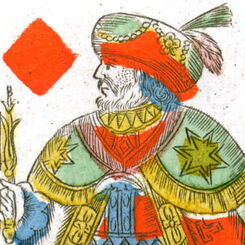
Johann Matheus Backofen
French-suited deck manufactured by Johann Matheus Backofen, Nürnberg c.1800.
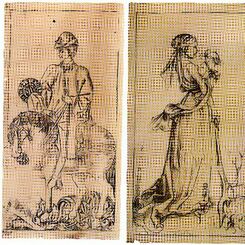
Early German Engraved Playing-cards
During the second half of the fifteenth century, with printing technology commercially established a...

Playing cards in the Upper Rhine region
Documentary evidence suggests that card playing established itself in Italy in 1376, and then spread...

South German Engraver
A pack of 52 cards with banner 10s, female 'Sotas', horsemen and kings, the pack was engraved in the...
Most Popular
Our top articles from the past 60 days


 Your comment here. Your comment here. Your comment here. Your comment here. Your comment here. Your comment here. Your comment here. Your comment here. Your comment here. Your comment here. Your comment here. Your comment here. Your comment here. Your comment here. Your comment here. Your comment here. Your comment here. Your comment here. Your comment here. Your comment here. Your comment here. Your comment here. Your comment here. Your comment here. Your comment here. Your comment here. Your comment here. Your comment here. Your comment here. Your comment here. Your comment here. Your comment here.
Your comment here. Your comment here. Your comment here. Your comment here. Your comment here. Your comment here. Your comment here. Your comment here. Your comment here. Your comment here. Your comment here. Your comment here. Your comment here. Your comment here. Your comment here. Your comment here. Your comment here. Your comment here. Your comment here. Your comment here. Your comment here. Your comment here. Your comment here. Your comment here. Your comment here. Your comment here. Your comment here. Your comment here. Your comment here. Your comment here. Your comment here. Your comment here.




















